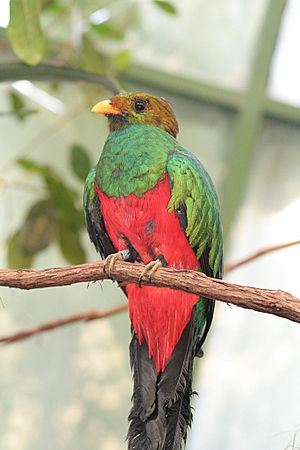Quetzal facts for kids
Quick facts for kids Quetzals |
|
|---|---|
 |
|
| Golden-headed quetzal | |
| Scientific classification | |
| Kingdom: | |
| Phylum: | |
| Class: | |
| Order: | |
| Family: | |
| Genus: | |
Quetzals are amazing, brightly colored birds. They belong to the trogon family. You can find them living in forests, especially in wet, high-up areas.
These beautiful birds live in the Americas. The word "quetzal" was first used for the resplendent quetzal. This famous bird has a very long tail and lives in Central America. The resplendent quetzal is a special national symbol for Guatemala.
Contents
What Quetzals Look Like
Quetzals have shiny green or golden-green feathers. These cover their wings, back, chest, and head. They also have a bright red belly.
Male and female quetzals look quite different. This is called sexual dimorphism. The males are usually much brighter and more colorful. Female quetzals often have brown or gray feathers in some places.
Where Quetzals Live and What They Eat
Quetzals are mostly solitary birds, meaning they like to be alone. They eat different things like fruits, berries, and insects. They also hunt small animals such as frogs. Even with their bright colors, quetzals can be hard to spot. They blend in well with their natural forest homes.
Quetzals in History
Long ago, the Aztecs thought the quetzal was a very important bird. They even worshipped it as the god of the air. The quetzal's long tail feathers were highly valued. These feathers can grow up to 2 feet (60 cm) long! The Aztecs used them to make special costumes and head-dresses.
The Name "Quetzal"
The name quetzal comes from an old language called Nahuatl. In Nahuatl, "quetzalli" means "large brilliant tail feather." It can also mean "tail feathers of the quetzal." The word comes from a root that means "stand up," referring to the bird's upright feathers. The word came into English through Spanish.
Protecting Quetzals
Most quetzal species are not in immediate danger. However, the eared quetzal and the resplendent quetzal are considered "Near Threatened." This means they could become endangered in the future.
The resplendent quetzal needs old, dead trees to make its nests. These trees are only found in certain types of forests called primary cloud forests. Protecting these forests is very important for the quetzal's survival. Organizations like the IUCN keep an eye on these birds.
Quetzals often live in cloud forests. But these forests are getting smaller and broken up. This is a big threat to the birds. Resplendent Quetzals sometimes move to lower areas in summer. This happens when there is more rain and lots of ripe fruits for them to eat.
Types of Quetzals
There are several different kinds of quetzals:
- Crested quetzal, Pharomachrus antisianus
- Golden-headed quetzal, Pharomachrus auriceps
- White-tipped quetzal, Pharomachrus fulgidus
- Resplendent quetzal, Pharomachrus mocinno
- Pavonine quetzal, Pharomachrus pavoninus
- Eared quetzal, Euptilotis neoxenus
The eared quetzal is closely related to the Pharomachrus group. Some experts call it the eared quetzal, while others call it the eared trogon.
Images for kids
-
Pair of quetzal figurines, 1733, hard-paste porcelain, overall: 31.8 x 9.2 x 8.3 cm, Metropolitan Museum of Art (New York City)


